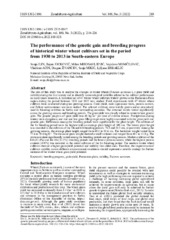Приказ основних података о документу
The performance of the genetic gain and breeding progress of historical winter wheat cultivars set in the period from 1930 to 2013 in south-eastern Europe
| dc.creator | Ilin, Sonja | |
| dc.creator | Jocković, Bojan | |
| dc.creator | Mirosavljević, Milan | |
| dc.creator | Momčilović, Vojislava | |
| dc.creator | Aćin, Vladimir | |
| dc.creator | Živančev, Dragan | |
| dc.creator | Mikić, Sanja | |
| dc.creator | Brbaklić, Ljiljana | |
| dc.date.accessioned | 2022-11-03T10:15:42Z | |
| dc.date.available | 2022-11-03T10:15:42Z | |
| dc.date.issued | 2022 | |
| dc.identifier.issn | 1392-3196 | |
| dc.identifier.uri | http://fiver.ifvcns.rs/handle/123456789/3207 | |
| dc.description.abstract | The aim of this study was to analyse the changes in winter wheat (Triticum aestivum L.) grain yield and stability during the last century and to identify meteorological variables related to the cultivar performance in many-years research. A historical set of 47 winter wheat cultivars widely grown in the Pannonian Plain region during the period between 1930 and 2013 was studied. Field experiments with 47 winter wheat cultivars were conducted during ten growing seasons. Grain yield, main agronomic traits, protein content, and Zeleny sedimentation test were studied. The selected cultivars were widely grown and/or extensively used in breeding activities in Serbia and surrounding countries. The obtained results varied significantly across the growing seasons and breeding periods. The grain yield was closely related to winter wheat genetic gain. The genetic progress of grain yield was 48 kg ha-1 per year of cultivar release. Precipitation during winter, stem elongation, and mid and late grain filling stages were highly associated with the grain yield and genetic gain. Differences among the breeding periods were significant for the plant height. The cultivars of the 1st breeding period were the highest with an average plant height of 109 cm. The lowest plant height was recorded in the cultivars of the 5th and 6th breeding periods: 78.5 and 80.5 cm, respectively. Among the growing seasons, the average plant height ranged from 69.5 to 98.6 cm. The hectolitre weight varied from 77.6 to 79.6 kg hl-1. The thousand grain weight showed a small variation and ranged from 40.1 to 41.9 g. The protein content significantly varied among the breeding periods and growing seasons. Modern cultivars of the 6th (12.4%) and the 4th (12.5%) breeding periods had the lowest protein content, while the highest protein content (14.0%) was recorded in the initial cultivars of the 1st breeding period. The modern winter wheat cultivars showed a higher grain yield potential and stability than older ones. Therefore, the improvement of cultivars stability across different environmental conditions should represent a notable strategy for further increase of the winter wheat grain yield potential. | sr |
| dc.language.iso | en | sr |
| dc.publisher | Kėdainiai : Lithuanian Research Centre for Agriculture and Forestry (LRCAF) | sr |
| dc.relation | info:eu-repo/grantAgreement/MESTD/inst-2020/200032/RS// | sr |
| dc.rights | openAccess | sr |
| dc.rights.uri | https://creativecommons.org/licenses/by/4.0/ | |
| dc.source | Zemdirbyste-Agriculture | sr |
| dc.subject | breeding | sr |
| dc.subject | breeding progress | sr |
| dc.subject | grain yield | sr |
| dc.subject | Pannonian plain | sr |
| dc.subject | stability | sr |
| dc.subject | Triticum aestivum | sr |
| dc.subject | wheat | sr |
| dc.subject | cultivars | sr |
| dc.title | The performance of the genetic gain and breeding progress of historical winter wheat cultivars set in the period from 1930 to 2013 in south-eastern Europe | sr |
| dc.type | article | sr |
| dc.rights.license | BY | sr |
| dc.citation.epage | 226 | |
| dc.citation.issue | 3 | |
| dc.citation.rank | M22 | |
| dc.citation.spage | 219 | |
| dc.citation.volume | 109 | |
| dc.identifier.doi | 10.13080/z-a.2022.109.028 | |
| dc.identifier.fulltext | http://fiver.ifvcns.rs/bitstream/id/9017/bitstream_9017.pdf | |
| dc.identifier.scopus | 2-s2.0-85138536805 | |
| dc.type.version | publishedVersion | sr |


